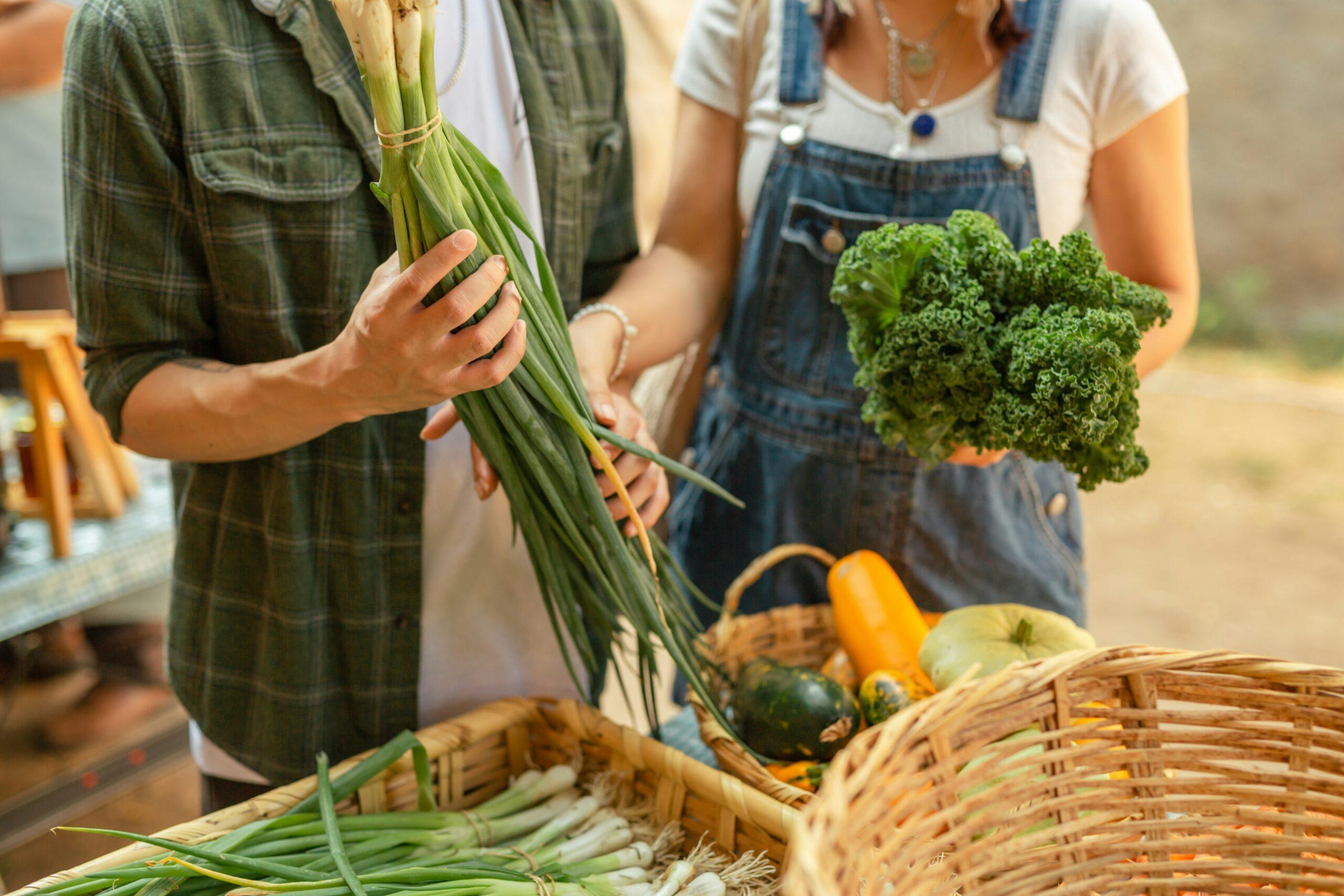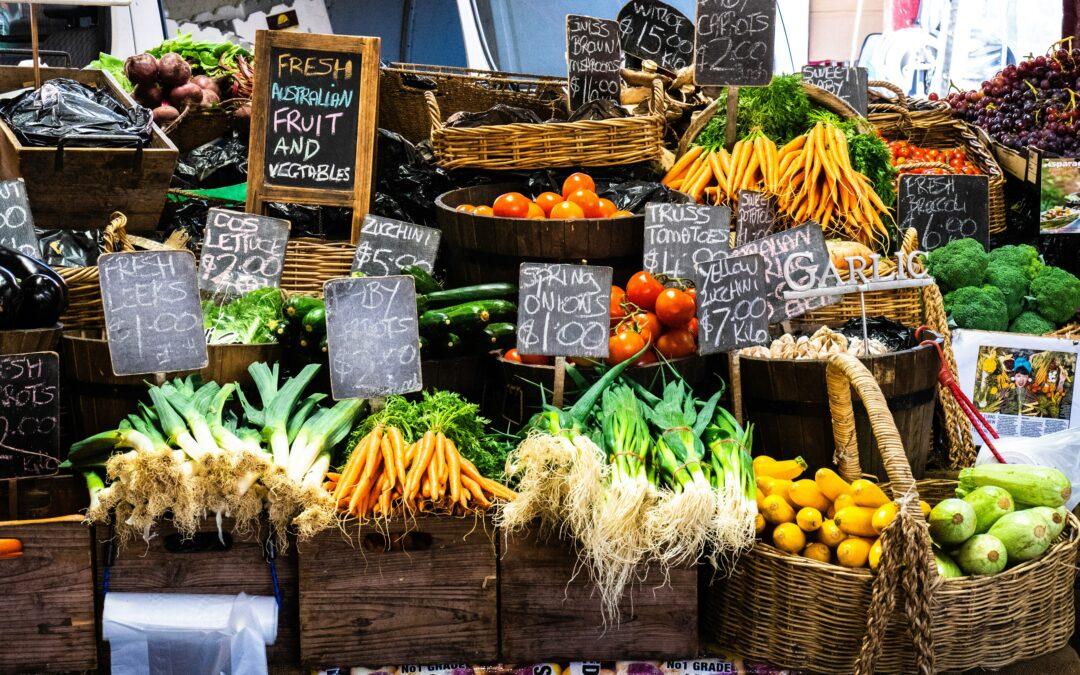You might be wondering what “eating in season” is, or “even whats the big deal about it?”. Well, “eating in season” means to eating foods that are seasonably available. A simple example would be, eating berries in berry picking season (rather than at some other time of the year).
But why eat seasonally?
There are many reasons to eat seasonally that benefit not just you, but others around you and your local economy.
Benefits of Eating In-Season
Supporting Local Farmers and Businesses
Buying in-season fruits and vegetables allows us to support local farmers and our local economies, as out-of-season fruits and vegetables are often grown and shipped from another country and solely found in the grocery store. Additionally, buying in-season fruits and vegetables directly from local farmers gives us a unique and often broader selection than what’s available in the grocery store.

Being Eco-Friendly
Choosing locally grown, in-season fruits and vegetable may be grown and produced locally can help reduce your eco-footprint. Local grown produce do not have to be imported from the far corners of the world, which means there are fewer greenhouse and transport emissions associated with them.
Reducing Your Shopping Bill
Buying in-season fruits and vegetables can also help ease your bank account. Local, in-season fruits and vegetables are available at the local farmer’s market, often at lower prices than the grocery store. We can also save a few dollars on those in-season fruits and vegetables that are not grown locally. When fruits and vegetables are in-season they are widely available, causing their retail price in the grocery store to drop, even if they are not grown locally.
Adding Essential Nutrients to Your Diet
Studies have found that fruits and vegetables grown in-season have a higher concentration of nutrients than those grown outside of their natural growing season. One study found broccoli grown in-season had a greater concentration of vitamin C than broccoli grown out of season. When grown in artificial conditions, fruits and veggies do not follow their natural growing and ripening patterns, resulting in changes in their nutrient content.
Additionally, fruits and vegetables that are grown out of season often require ripening agents or further processing for ripening and transportation. These processes can either accelerate or limit the ripening of fruits and vegetables as they are transported to the local grocery stores.

Find Out Whats In-Season
The table below includes fruits and vegetables that are typically in season throughout the calendar year. Many fruits are avialble for many months throughout the year.
Keep in mind, that availability of fruits and vegetables can vary depending on your climate.
January
- Bananas
- Grapefruit and oranges
- Lemons
- Mushrooms
- Onions & leeks
- Oranges
- Potatoes and sweet potatoes
- Yams
- Turnips
- Winter squash
February
- Bananas
- Grapefruit
- Lemons
- Onions and leeks
- Oranges
- Pears
- Potatoes and sweet potatoes
- Turnips
- Yams
- Winter squash
March
- Bananas
- Grapefruit
- Lemons
- Onions and leeks
- Oranges
- Pears
- Potatoes and sweet potatoes
- Turnips
- Yams
- Winter squash
April
- Apricots
- Bananas
- Strawberries
- Honeydew melon
- Mangoes
- Pineapple
- Mushrooms
- Lettuce, cabbage and spinach
- Onions and leeks
- Peas
May
- Apricots
- Bananas
- Strawberries
- Honeydew melon
- Mangoes
- Pineapple
- Mushrooms
- Lettuce, cabbage and spinach
- Onions and leeks
- Peas
June
- Apricots and peaches
- Blackberries, blueberries, raspberries and strawberries
- Honeydew melon and watermelon
- Grapes
- Kiwis
- Bananas
- Nectarines
- Summer squash and zucchini
- Cherries
- Tomatillos and tomatoes
- Bell peppers
- Corn
- Radishes
July
- Rhubarb
- Strawberries
- Brocolli
- Green beans
- Cherries
- Cucumber
- Asparagus
- Sweet potato
- Mushrooms
- Cabbage
September
- Apples
- Bananas
- Beerts
- Broccoli and cauliflower
- Brussel sprouts
- Carrots and parsnips
- Sweet potatoes and yams
- Pineapple
- Pumpkins and winter squash
- Grapes
- Ginger
- Garlic
- Pears
October
- Apples
- Bananas
- Beets
- Winter squash and pumpkins
- Sweet potatoes and yams
- Garlic
- Grapes
- Mushrooms
- Pears
November
Apples, Bananas, Beets, Broccoli, Brussels Sprouts, Carrots, Cauliflower, Cranberries, Garlic, Ginger, Grapes, Mushrooms, Parsnips, Pears, Pineapple, Pumpkins, Sweet Potatoes and Yams, Winter Squash
December
- Bananas
- Grapefruit
- Lemons and oranges
- Pears
- Potatoes, sweet potatoes, yams and turnips
- Winter squash
- Onions and leeks
Takeaway
Embracing seasonal eating is a great way to add flavour to your diet while promoting your health and supporting the environment and your local economy.
Meal Plans with Seasonal Produce
Our team of Registered Dietitians and Nutritionists can work with you to develop a personalized meal plan that incorporates seasonal produce!
Book a FREE discovery call to get started.
With a Bachelor of Science in Nutrition and Food Science, Rachel has over 15 years’ experience helping people address their health through nutrition.



